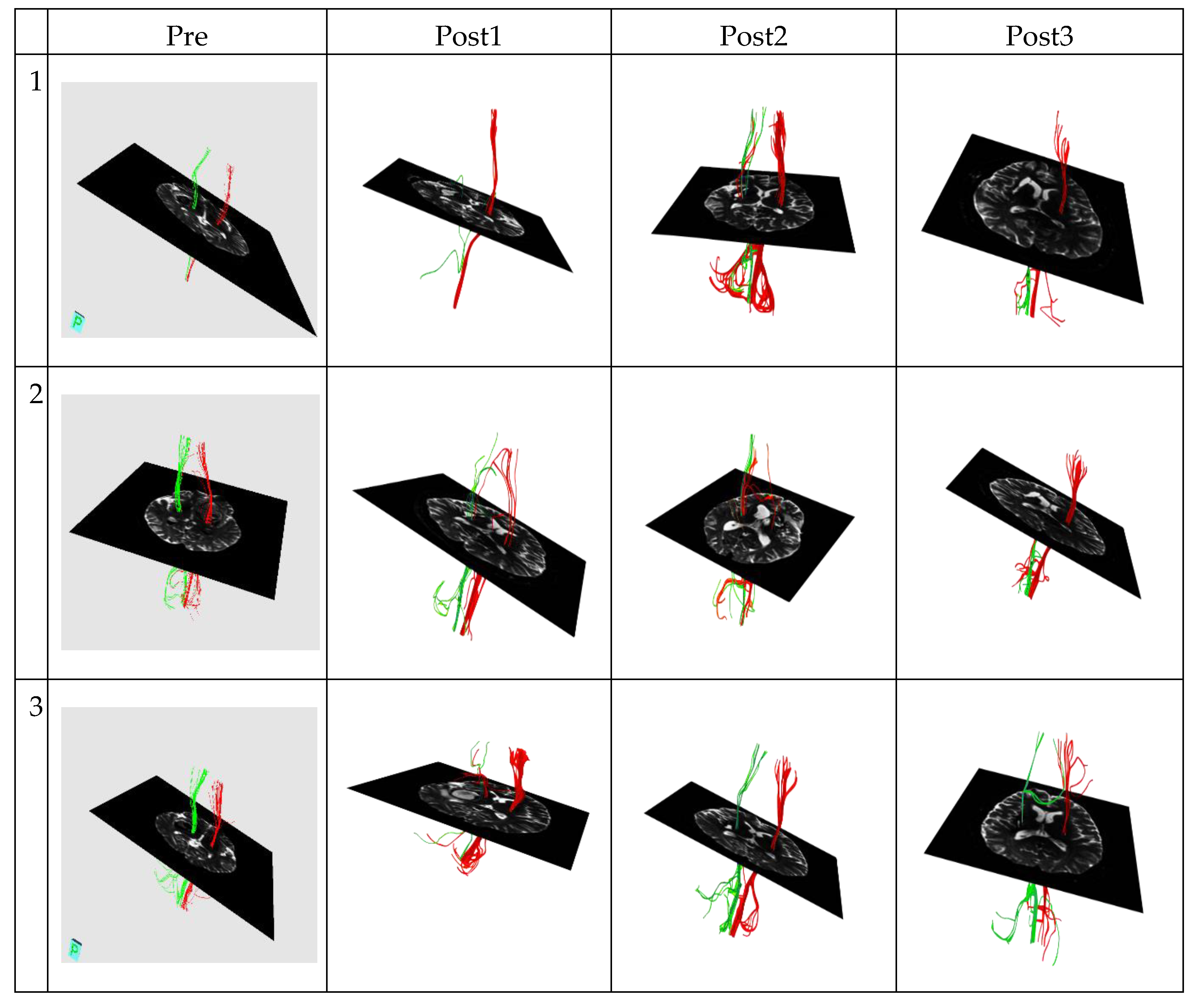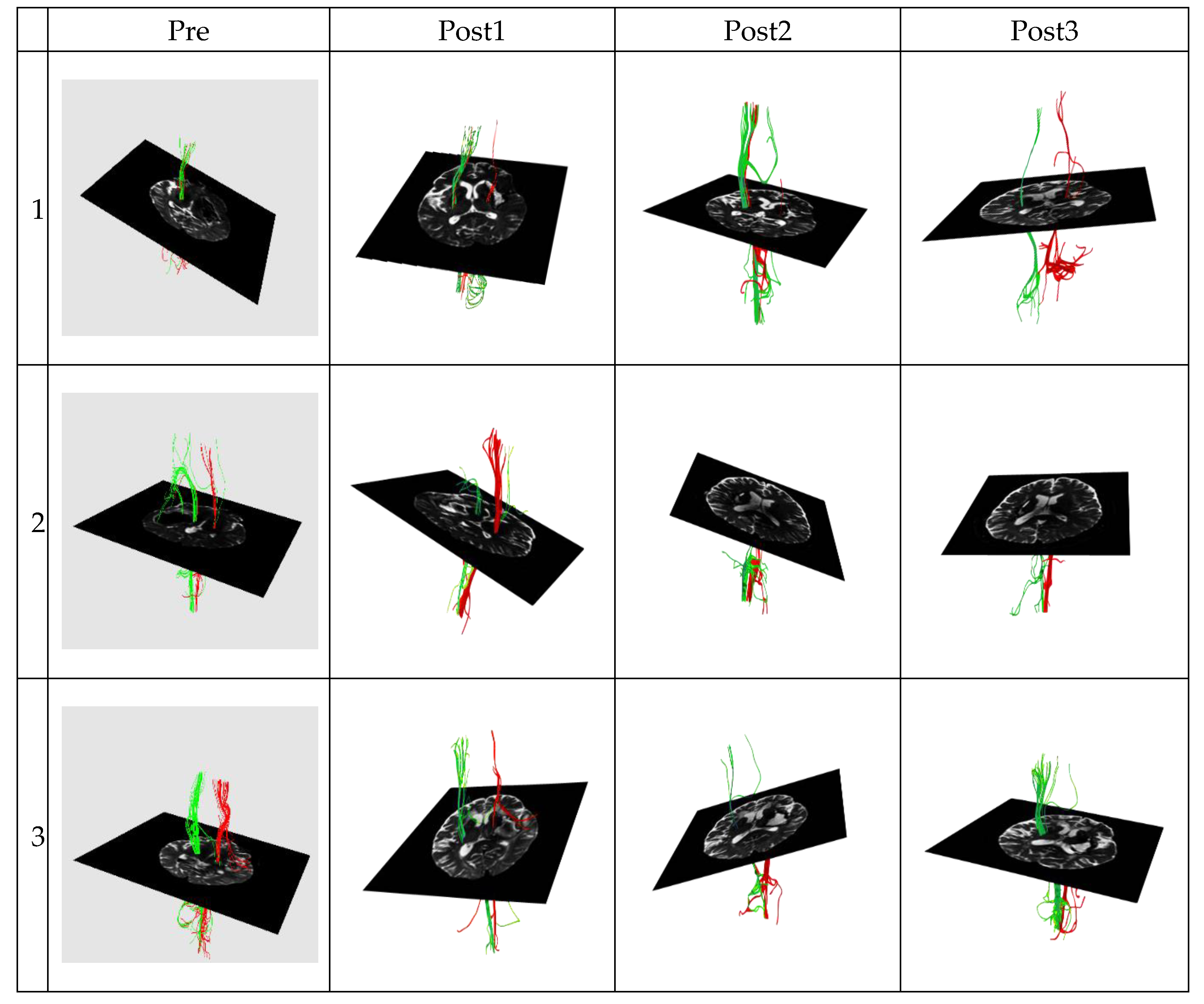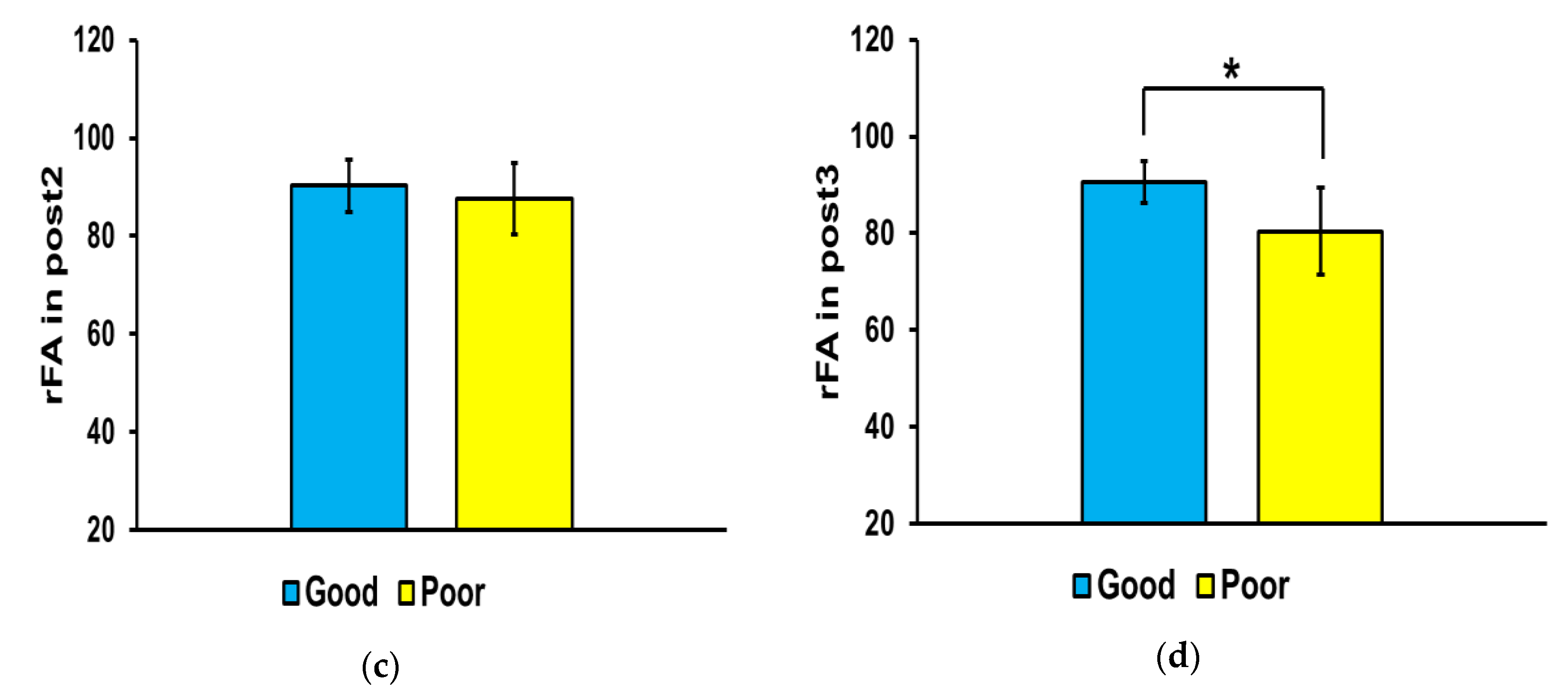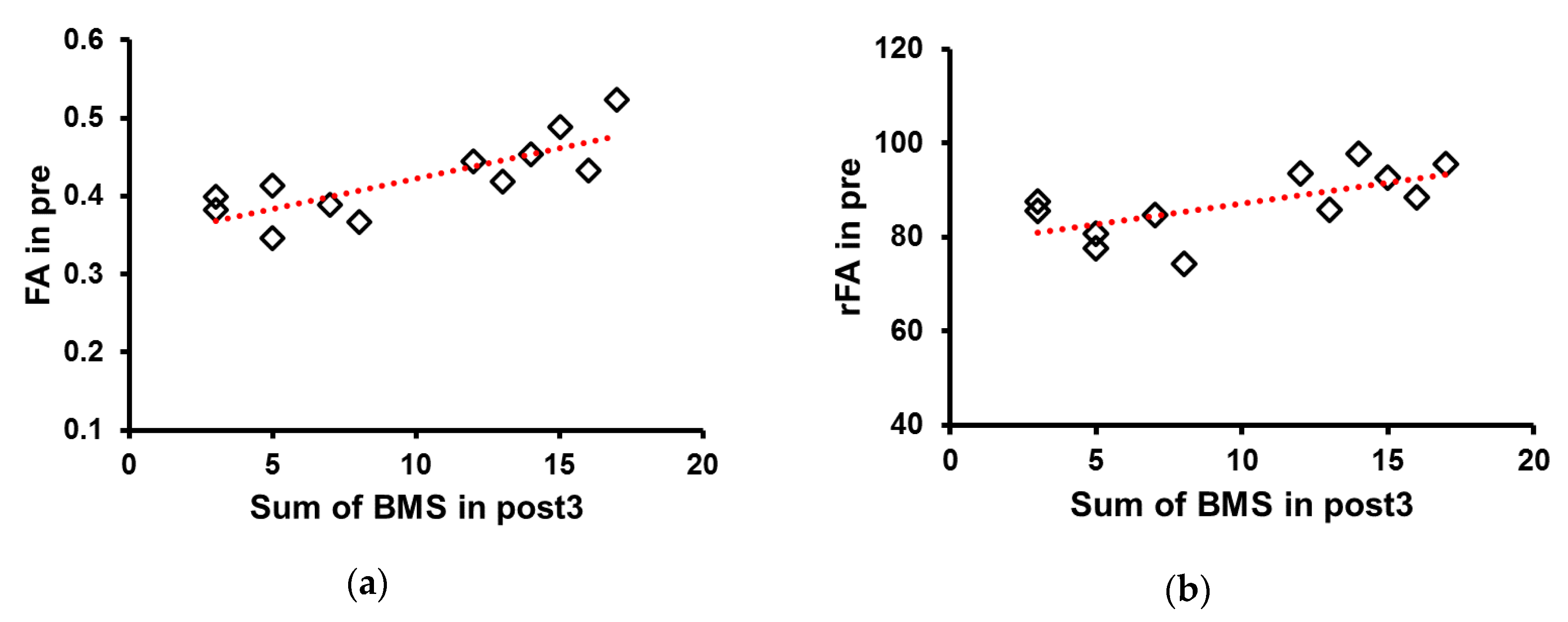Prediction of Motor Recovery in Patients with Basal Ganglia Hemorrhage Using Diffusion Tensor Imaging
Abstract
1. Introduction
2. Materials and Methods
2.1. Participants
2.2. Evaluation of Clinical Outcome
2.3. Diffusion Tensor Tractography
2.4. Voxel-Wise Analysis of DTI Metrics
2.5. Statistical Analysis
3. Results
3.1. Patient Characteristics and Diffusion Tensor Tractography (DTT) Data
3.2. FA Differences in the Affected and Non-Affected Sides of the Brain
3.3. Correlation of FA Values and FA Ratio at Pre with the Sum of BMS Score at Post3
4. Discussion
5. Conclusions
Author Contributions
Funding
Conflicts of Interest
References
- Andersen, K.K.; Olsen, T.S.; Dehlendorff, C.; Kammersgaard, L.P. Hemorrhagic and Ischemic Strokes Compared. Stroke 2009, 40, 2068–2072. [Google Scholar] [CrossRef] [PubMed]
- Byblow, W.D.; Stinear, C.M.; Barber, P.A.; Petoe, M.A.; Ackerley, S.J. Proportional recovery after stroke depends on corticomotor integrity. Ann. Neurol. 2015, 78, 848–859. [Google Scholar] [CrossRef] [PubMed]
- Stinear, C. Prediction of recovery of motor function after stroke. Lancet Neurol. 2010, 9, 1228–1232. [Google Scholar] [CrossRef]
- Senesh, M.R.; Reinkensmeyer, D.J. Breaking Proportional Recovery After Stroke. Neurorehabil. Neural Repair 2019, 33, 888–901. [Google Scholar] [CrossRef] [PubMed]
- Hope, T.M.H.; Friston, K.; Price, C.J.; Leff, A.P.; Rotshtein, P.; Bowman, H. Recovery after stroke: Not so proportional after all? Brain 2019, 142, 15–22. [Google Scholar] [CrossRef]
- Zhao, X.; Sun, G.; Zhang, H.; Ting, S.-M.; Song, S.; Gonzales, N.; Aronowski, J. Polymorphonuclear neutrophil in brain parenchyma after experimental intracerebral hemorrhage. Transl. Stroke Res. 2014, 5, 554–561. [Google Scholar] [CrossRef]
- Hatakeyama, T.; Okauchi, M.; Hua, Y.; Keep, R.F.; Xi, G. Deferoxamine reduces neuronal death and hematoma lysis after intracerebral hemorrhage in aged rats. Transl. Stroke Res. 2013, 4, 546–553. [Google Scholar] [CrossRef]
- Zhou, Y.; Wang, Y.; Wang, J.; Anne Stetler, R.; Yang, Q.-W. Inflammation in intracerebral hemorrhage: From mechanisms to clinical translation. Prog. Neurobiol. 2014, 115, 25–44. [Google Scholar] [CrossRef]
- Xi, G.; Keep, R.F.; Hoff, J.T. Mechanisms of brain injury after intracerebral haemorrhage. Lancet Neurol. 2006, 5, 53–63. [Google Scholar] [CrossRef]
- Egashira, Y.; Hua, Y.; Keep, R.F.; Xi, G. Acute white matter injury after experimental subarachnoid hemorrhage: Potential role of lipocalin 2. Stroke 2014, 45, 2141–2143. [Google Scholar] [CrossRef]
- Chaudhary, N.; Pandey, A.S.; Gemmete, J.J.; Hua, Y.; Huang, Y.; Gu, Y.; Xi, G. Diffusion tensor imaging in hemorrhagic stroke. Exp. Neurol. 2015, 272, 88–96. [Google Scholar] [CrossRef] [PubMed]
- Puig, J.; Blasco, G.; Schlaug, G.; Stinear, C.M.; Daunis-I-Estadella, P.; Biarnes, C.; Figueras, J.; Serena, J.; Hernández-Pérez, M.; Alberich-Bayarri, A.; et al. Diffusion tensor imaging as a prognostic biomarker for motor recovery and rehabilitation after stroke. Neuroradiology 2017, 59, 343–351. [Google Scholar] [CrossRef] [PubMed]
- Bajaj, S.; Vanuk, J.R.; Smith, R.; Dailey, N.S.; Killgore, W.D.S. Blue-Light Therapy following Mild Traumatic Brain Injury: Effects on White Matter Water Diffusion in the Brain. Front. Neurol. 2017, 8, 616. [Google Scholar] [CrossRef] [PubMed]
- Yeh, F.-C.; Verstynen, T.D.; Wang, Y.; Fernández-Miranda, J.C.; Tseng, W.-Y.I. Deterministic Diffusion Fiber Tracking Improved by Quantitative Anisotropy. PLoS ONE 2013, 8, e80713. [Google Scholar] [CrossRef] [PubMed]
- Prabhakaran, S.; Zarahn, E.; Riley, C.; Speizer, A.; Chong, J.Y.; Lazar, R.M.; Marshall, R.S.; Krakauer, J.W. Inter-individual variability in the capacity for motor recovery after ischemic stroke. Neurorehabil. Neural Repair 2008, 22, 64–71. [Google Scholar] [CrossRef]
- Winters, C.; van Wegen, E.E.H.; Daffertshofer, A.; Kwakkel, G. Generalizability of the Proportional Recovery Model for the Upper Extremity After an Ischemic Stroke. Neurorehabil. Neural Repair 2015, 29, 614–622. [Google Scholar] [CrossRef]
- Coupar, F.; Pollock, A.; Rowe, P.; Weir, C.; Langhorne, P. Predictors of upper limb recovery after stroke: A systematic review and meta-analysis. Clin. Rehabil. 2012, 26, 291–313. [Google Scholar] [CrossRef]
- Hendricks, H.T.; van Limbeek, J.; Geurts, A.C.; Zwarts, M.J. Motor recovery after stroke: A systematic review of the literature. Arch Phys. Med. Rehabil. 2002, 83, 1629–1637. [Google Scholar] [CrossRef]
- Puig, J.; Pedraza, S.; Blasco, G.; Daunis-I-Estadella, J.; Prats, A.; Prados, F.; Boada, I.; Castellanos, M.; Sánchez-González, J.; Remollo, S.; et al. Wallerian degeneration in the corticospinal tract evaluated by diffusion tensor imaging correlates with motor deficit 30 days after middle cerebral artery ischemic stroke. AJNR Am. J. Neuroradiol. 2010, 31, 1324–1330. [Google Scholar] [CrossRef]
- Thomalla, G.; Glauche, V.; Koch, M.A.; Beaulieu, C.; Weiller, C.; Röther, J. Diffusion tensor imaging detects early Wallerian degeneration of the pyramidal tract after ischemic stroke. NeuroImage 2004, 22, 1767–1774. [Google Scholar] [CrossRef]
- Kusano, Y.; Seguchi, T.; Horiuchi, T.; Kakizawa, Y.; Kobayashi, T.; Tanaka, Y.; Seguchi, K.; Hongo, K. Prediction of functional outcome in acute cerebral hemorrhage using diffusion tensor imaging at 3T: A prospective study. AJNR Am. J. Neuroradiol. 2009, 30, 1561–1565. [Google Scholar] [CrossRef] [PubMed]
- Kuzu, Y.; Inoue, T.; Kanbara, Y.; Nishimoto, H.; Fujiwara, S.; Ogasawara, K.; Ogawa, A. Prediction of motor function outcome after intracerebral hemorrhage using fractional anisotropy calculated from diffusion tensor imaging. Cerebrovasc. Dis. 2012, 33, 566–573. [Google Scholar] [CrossRef] [PubMed]
- Wang, D.-M.; Li, J.; Liu, J.-R.; Hu, H.-Y. Diffusion Tensor Imaging Predicts Long-Term Motor Functional Outcome in Patients with Acute Supratentorial Intracranial Hemorrhage. Cerebrovasc. Dis. 2012, 34, 199–205. [Google Scholar] [CrossRef]
- Ma, C.; Liu, A.; Li, Z.; Zhou, X.; Zhou, S. Longitudinal study of diffusion tensor imaging properties of affected cortical spinal tracts in acute and chronic hemorrhagic stroke. J. Clin. Neurosci. 2014, 21, 1388–1392. [Google Scholar] [CrossRef]
- Wu, G.; Wang, L.; Hong, Z.; Mao, Y.; Hu, X. Effects of minimally invasive techniques for evacuation of hematoma in basal ganglia on cortical spinal tract from patients with spontaneous hemorrhage: Observed by diffusion tensor imaging. Neurol. Res. 2010, 32, 1103–1109. [Google Scholar] [CrossRef] [PubMed]
- Koyama, T.; Tsuji, M.; Miyake, H.; Ohmura, T.; Domen, K. Motor Outcome for Patients with Acute Intracerebral Hemorrhage Predicted Using Diffusion Tensor Imaging: An Application of Ordinal Logistic Modeling. J. Stroke Cerebrovasc. Dis. 2012, 21, 704–711. [Google Scholar] [CrossRef] [PubMed]
- Wang, L.E.; Tittgemeyer, M.; Imperati, D.; Diekhoff, S.; Ameli, M.; Fink, G.R.; Grefkes, C. Degeneration of corpus callosum and recovery of motor function after stroke: A multimodal magnetic resonance imaging study. Hum. Brain Mapp. 2012, 33, 2941–2956. [Google Scholar] [CrossRef] [PubMed]
- Stejskal, E.O.; Tanner, J.E. Spin Diffusion Measurements: Spin Echoes in the Presence of a Time-Dependent Field Gradient. J. Chem. Phys. 1965, 42, 288–292. [Google Scholar] [CrossRef]
- Fillard, P.; Souplet, J.-C.; Toussaint, N. Medical Image Navigation and Research Tool by INRIA (MedINRIA 1.9) Tutorial v2.0. 57. Available online: http://www-sop.inria.fr/asclepios/software/MedINRIA/doc/usermanual/MedINRIA.pdf (accessed on 29 April 2020).
- Seo, J.P.; Jang, S.H. Characteristics of corticospinal tract area according to pontine level. Yonsei Med. J. 2013, 54, 785–787. [Google Scholar] [CrossRef]
- Koay, C.G.; Chang, L.-C.; Carew, J.D.; Pierpaoli, C.; Basser, P.J. A unifying theoretical and algorithmic framework for least squares methods of estimation in diffusion tensor imaging. J. Magn. Reson. 2006, 182, 115–125. [Google Scholar] [CrossRef]
- Zhang, M.; Lin, Q.; Lu, J.; Rong, D.; Zhao, Z.; Ma, Q.; Liu, H.; Shu, N.; He, Y.; Li, K. Pontine infarction: Diffusion-tensor imaging of motor pathways-a longitudinal study. Radiology 2015, 274, 841–850. [Google Scholar] [CrossRef]
- Puig, J.; Pedraza, S.; Blasco, G.; Daunis-i-Estadella, J.; Prados, F.; Remollo, S.; Prats-Galino, A.; Soria, G.; Boada, I.; Castellanos, M.; et al. Acute Damage to the Posterior Limb of the Internal Capsule on Diffusion Tensor Tractography as an Early Imaging Predictor of Motor Outcome after Stroke. Am. J. Neuroradiol. 2011, 32, 857–863. [Google Scholar] [CrossRef] [PubMed]
- Feys, H.; Hetebrij, J.; Wilms, G.; Dom, R.; De Weerdt, W. Predicting arm recovery following stroke: Value of site of lesion. Acta Neurol. Scand. 2000, 102, 371–377. [Google Scholar] [CrossRef] [PubMed]
- Duncan, P.W. Outcome measures in stroke rehabilitation. Handb Clin. Neurol. 2013, 110, 105–111. [Google Scholar] [CrossRef] [PubMed]
- Cunningham, D.A.; Machado, A.; Janini, D.; Varnerin, N.; Bonnett, C.; Yue, G.; Jones, S.; Lowe, M.; Beall, E.; Sakaie, K.; et al. The Assessment of Inter-Hemispheric Imbalance using Imaging and Non-Invasive Brain Stimulation in Patients with Chronic Stroke. Arch Phys. Med. Rehabil. 2015, 96, S94–S103. [Google Scholar] [CrossRef] [PubMed]
- Bajaj, S.; Housley, S.N.; Wu, D.; Dhamala, M.; James, G.A.; Butler, A.J. Dominance of the Unaffected Hemisphere Motor Network and Its Role in the Behavior of Chronic Stroke Survivors. Front. Hum. Neurosci. 2016, 10, 650. [Google Scholar] [CrossRef] [PubMed]
- Jang, S.H.; Jang, W.H. Change of the Corticospinal Tract in the Unaffected Hemisphere by Change of the Dominant Hand Following Stroke. Medicine 2016, 95. [Google Scholar] [CrossRef]
- Li Motor Imagery Training Induces Changes in Brain Neural Networks in Stroke Patients. Available online: http://www.nrronline.org/article.asp?issn=1673-5374;year=2018;volume=13;issue=10;spage=1771;epage=1781;aulast=Li (accessed on 13 April 2020).
- Lin, L.Y.; Ramsey, L.; Metcalf, N.V.; Rengachary, J.; Shulman, G.L.; Shimony, J.S.; Corbetta, M. Stronger prediction of motor recovery and outcome post-stroke by cortico-spinal tract integrity than functional connectivity. PLoS ONE 2018, 13, e0202504. [Google Scholar] [CrossRef]
- Almeida, S.R.M.; Vicentini, J.; Bonilha, L.; De Campos, B.M.; Casseb, R.F.; Min, L.L. Brain Connectivity and Functional Recovery in Patients With Ischemic Stroke. J. Neuroimaging 2017, 27, 65–70. [Google Scholar] [CrossRef]






| Patient No. | Age (Years)/Sex | Treatment | Location of ICH | Volume of ICH (mL) | Period * | DT Imaging Data | ||
|---|---|---|---|---|---|---|---|---|
| FA in Affected Hemisphere | FA in non-Affected Hemisphere | FA Ratio ** | ||||||
| 1 | 36/M | Stereotactic aspiration | Lt. Putamen | 18.85 | Pre | 0.52 | 0.55 | 95.62 |
| Post1 | 0.42 | 0.44 | 93.82 | |||||
| Post2 | 0.41 | 0.43 | 95.52 | |||||
| Post3 | 0.41 | 0.45 | 92.76 | |||||
| 2 | 57/M | Stereotactic aspiration | Rt. Putamen | 35.40 | Pre | 0.45 | 0.46 | 97.72 |
| Post1 | 0.43 | 0.45 | 96.47 | |||||
| Post2 | 0.44 | 0.48 | 93.17 | |||||
| Post3 | 0.45 | 0.48 | 95.25 | |||||
| 3 | 31/M | Stereotactic aspiration | Lt. Basal Ganglia | 40.50 | Pre | 0.49 | 0.53 | 92.76 |
| Post1 | 0.41 | 0.47 | 85.69 | |||||
| Post2 | 0.41 | 0.51 | 81.46 | |||||
| Post3 | 0.47 | 0.50 | 92.81 | |||||
| 4 | 48/M | Conservative | Lt. Putamen | 11.50 | Pre | 0.44 | 0.47 | 93.57 |
| Post1 | 0.41 | 0.49 | 85.27 | |||||
| Post2 | 0.44 | 0.50 | 89.36 | |||||
| Post3 | 0.44 | 0.49 | 89.17 | |||||
| 5 | 52/F | Stereotactic aspiration | Lt. Basal Ganglia | 10.5 | Pre | 0.42 | 0.49 | 85.83 |
| Post1 | 0.37 | 0.41 | 90.93 | |||||
| Post2 | ||||||||
| Post3 | 0.38 | 0.42 | 90.53 | |||||
| 6 | 49/F | Conservative | Lt. Basal Ganglia | 11.6 | Pre | 0.43 | 0.49 | 88.47 |
| Post1 | 0.40 | 0.49 | 81.99 | |||||
| Post2 | 0.41 | 0.45 | 91.74 | |||||
| Post3 | 0.41 | 0.50 | 82.65 | |||||
| Patient No. | Age (Years)/Sex | Treatment | Location of ICH | Volume of ICH (mL) | Period * | DT Imaging Data | ||
|---|---|---|---|---|---|---|---|---|
| FA in Affected Hemisphere | FA in Non-Affected Hemisphere | FA Ratio ** | ||||||
| 1 | 46/M | Conservative | Rt. Basal Ganglia | 29.061 | Pre | 0.37 | 0.49 | 74.40 |
| Post1 | 0.29 | 0.49 | 59.11 | |||||
| Post2 | 0.39 | 0.45 | 87.41 | |||||
| Post3 | 0.40 | 0.46 | 86.97 | |||||
| 2 | 67/F | Stereotactic aspiration | Rt. Putamen | 28.91 | Pre | 0.38 | 0.45 | 85.51 |
| Post1 | 0.38 | 0.44 | 84.87 | |||||
| Post2 | 0.42 | 0.46 | 89.97 | |||||
| Post3 | 0.30 | 0.42 | 71.49 | |||||
| 3 | 69/M | Conservative | Lt. Putamen | 27.385 | Pre | 0.35 | 0.45 | 77.71 |
| Post1 | 0.35 | 0.41 | 86.87 | |||||
| Post2 | 0.36 | 0.40 | 91.49 | |||||
| Post3 | 0.38 | 0.43 | 88.12 | |||||
| 4 | 38/M | Conservative | Lt. Basal Ganglia | 53.54 | Pre | 0.41 | 0.51 | 80.70 |
| Post1 | 0.46 | 0.47 | 97.25 | |||||
| Post2 | 0.42 | 0.43 | 98.05 | |||||
| Post3 | 0.38 | 0.53 | 70.29 | |||||
| 5 | 70/F | Conservative | Rt. Putamen | 18.20 | Pre | 0.40 | 0.46 | 87.64 |
| Post1 | 0.33 | 0.49 | 68.42 | |||||
| Post2 | 0.37 | 0.47 | 77.65 | |||||
| Post3 | 0.35 | 0.47 | 75.25 | |||||
| 6 | 46/M | Conservative | Rt. Basal Ganglia | 8.761 | Pre | 0.39 | 0.46 | 84.76 |
| Post1 | 0.36 | 0.43 | 84.58 | |||||
| Post2 | 0.41 | 0.51 | 81.56 | |||||
| Post3 | 0.43 | 0.47 | 90.01 | |||||
© 2020 by the authors. Licensee MDPI, Basel, Switzerland. This article is an open access article distributed under the terms and conditions of the Creative Commons Attribution (CC BY) license (http://creativecommons.org/licenses/by/4.0/).
Share and Cite
Min, Y.-S.; Jang, K.E.; Park, E.; Kim, A.-R.; Kang, M.-G.; Cheong, Y.-S.; Kim, J.-H.; Jung, S.-H.; Park, J.; Jung, T.-D. Prediction of Motor Recovery in Patients with Basal Ganglia Hemorrhage Using Diffusion Tensor Imaging. J. Clin. Med. 2020, 9, 1304. https://doi.org/10.3390/jcm9051304
Min Y-S, Jang KE, Park E, Kim A-R, Kang M-G, Cheong Y-S, Kim J-H, Jung S-H, Park J, Jung T-D. Prediction of Motor Recovery in Patients with Basal Ganglia Hemorrhage Using Diffusion Tensor Imaging. Journal of Clinical Medicine. 2020; 9(5):1304. https://doi.org/10.3390/jcm9051304
Chicago/Turabian StyleMin, Yu-Sun, Kyung Eun Jang, Eunhee Park, Ae-Ryoung Kim, Min-Gu Kang, Youn-Soo Cheong, Ju-Hyun Kim, Seung-Hwan Jung, Jaechan Park, and Tae-Du Jung. 2020. "Prediction of Motor Recovery in Patients with Basal Ganglia Hemorrhage Using Diffusion Tensor Imaging" Journal of Clinical Medicine 9, no. 5: 1304. https://doi.org/10.3390/jcm9051304
APA StyleMin, Y.-S., Jang, K. E., Park, E., Kim, A.-R., Kang, M.-G., Cheong, Y.-S., Kim, J.-H., Jung, S.-H., Park, J., & Jung, T.-D. (2020). Prediction of Motor Recovery in Patients with Basal Ganglia Hemorrhage Using Diffusion Tensor Imaging. Journal of Clinical Medicine, 9(5), 1304. https://doi.org/10.3390/jcm9051304





